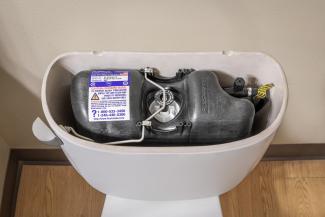
If you don’t consider pressure-assisted flushing, you’re missing out on several benefits that can improve guests’ and residents’ experiences, along with your bottom line.
Want proof? Here are three case studies that demonstrate why every property manager and facility engineer should consider pressure-assisted toilets.
Luxor Hotel, Las Vegas: 2,500 Rooms, Virtually No Clogged Toilets
The Luxor Hotel in Las Vegas includes seven restaurants, a 100,000-square-foot casino, a 110-seat showroom, and 2,526 rooms. And every water closet in the gigantic complex is equipped with a Flushmate pressure-assisted flush system.
Why? Because pressure-assisted water closets—also known as power flush toilets—are far less likely to clog, and that means the hotel’s maintenance staff can focus on other tasks.
“My previous experience was at an operation that had three-gallon gravity units, and we would get as many as 10 calls a shift,” says Jim Brown, assistant chief engineer at the Luxor. “Since the Luxor opened, we’re averaging only two to three water closet maintenance calls a shift.”
Lochwood Apartments, Baltimore: Complete ROI in 24 Months
The company that manages Baltimore’s luxury Lochwood Apartments believes in being proactive about maintenance and water savings. Flushmate pressure-assisted flush systems help them accomplish both.
“My crews were busy unplugging toilets instead of doing their other maintenance responsibilities,” says Bret Hopkins, Managing Member for Fairfax Station Enterprises, LLC. “For example, I had one tenant with special needs, and we were in that unit about once a week unplugging the toilet. I decided to test a Flushmate-equipped fixture in that unit to reduce the maintenance calls. The performance was outstanding—virtually eliminating all maintenance issues since installation.”
Flushmate’s 1.0 gallon per flush pressure-assisted system also helped the 356-unit complex demonstrate a 57% average drop in daily cubic foot water usage and a 46% average reduction in water costs. Hopkins says, “Based on our current water rates, the ROI on these toilets will be less than 24 months.”
He adds, “We have had such positive results, from dramatically fewer maintenance calls and lower water bills, that we have begun to implement Flushmate at three more properties.”
Sequoia National Park: The Core of a Massive Water Conservation Plan
The Giant Forest area of Sequoia National Park is home to hundreds of thousand-year-old trees—along with an aging, 200-building facility. While a new facility was being built, the National Park Service needed to achieve full compliance with wastewater treatment standards to keep the older facility open.
These drastic measures required a massive water conservation plan, including new showerheads, faucets, and dishwashers. But the most critical upgrade was the installation of 250 water closets equipped with the Flushmate 1.6 gpf pressure-assisted system.
The total plan was initially expected to save 18,000 gallons of water per day, but during the busiest months from May to September, water flow was actually reduced by an average of about 32,000 gallons a day—nearly 53%.
“It was a success like you wouldn’t believe,” says Mark Malmquist, maintenance manager for Sequoia National Parks. He also reports a 100% payback on the water-saving program in less than 7 months after installation.
How Do Pressure-assisted Toilets Deliver these Benefits?
Most ordinary toilets use gravity to flush their contents. When a flush is triggered, the water in the tank essentially just falls into the bowl, with the force of the falling water creating a siphon effect that pulls the bowl’s contents down the drainpipe.
A pressure-assisted toilet contains a sealed tank that compresses trapped air and uses the water supply line pressure to compress the trapped air. When a flush is triggered, this compressed air expands and forces the water into the bowl, so instead of “pulling” waste out with a siphon action, the pressure-assist unit “pushes” waste out.
Power flush toilets can produce a longer drainline carry, pushing waste up to 50% further than the recommendations set by the American National Standards Institute.
This powerful flushing action is why a pressure-assisted toilet is far less likely to clog—even using as little as 1 gallon per flush.
It’s also why so many facilities have discovered why pressure-assisted toilets make so much sense. Want more proof? Check out the rest of our case studies!
Are pressure-assisted toilets right for your next apartment complex, hotel, restaurant, or public facility? Talk to the experts at Flushmate!